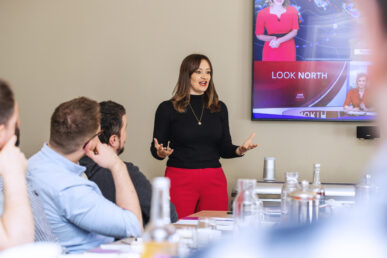“What people care about is connection”
6 Tips To Talk On Camera Like A Pro
Many people are anxious about public speaking. But when they hear it is being filmed their fear goes through the roof.
All of a sudden, they become tense and their natural flow disappears. They may fear that any small mistake will be captured forever. Plus very few people like hearing their voice on a recording!
Even when you can delete the recording and try again you are faced with another challenge. When talking on camera there is no live energy to feed off. You have to bring enough of your own energy to the lens to make up for the lack of audience, which can feel strange — because regardless of how frequently we use technology, we still aren’t used to talking to a camera. And unfortunately, any discomfort with a lens will translate to your speech.
Thankfully, speaking on camera can be done successfully by following a few simple tips:
1. Maintain eye (“lens”) contact.
When you’re speaking on camera, you should be looking in the direction of the lens — or directly into it.
This is the on-camera equivalent of maintaining eye contact. You’ll want to do all the same things for this step as you would if you were speaking in person: practice what you’re going to say, know your trigger words, don’t stare directly at your notes, etc.
Looking into the camera will make you appear more confident and knowledgeable than if you’re speaking to an interviewer or person off-camera. And it will help your audience engage with what you’re saying. They’ll feel like you’re saying it directly to them — not to someone out of the frame.
2. Talk to one person — not a fan base.
A lot of famous YouTube personalities start their videos with a cheerey, “Hey guys!” as if a group of 100 people are watching it together.
Most people watch videos alone, usually on a smartphone or tablet. This means you’re technically speaking to only one person. So starting a video with a big arm wave and group greeting will break the illusion that you’re speaking directly to the viewer.
And the viewer wants that connection. Speaking on camera as if you’re only talking to one person will make people feel more engaged, like you’re speaking to them as a friend and not a stranger on the Internet.
3. The lens won’t hurt you, so don’t be afraid to get friendly.
Sometimes the camera lens can look like a threatening object pointed directly at your face.
But don’t worry — imagine that the lens is a close friend. It’s there to help you send your ideas to your audience, no matter where they are. So, relax your shoulders, look at the lens directly, and smile. It may feel strange at first, but by making the leap in your imagination that the lens is someone you’re talking with and not a piece of plastic, you’ll come across as more engaging and real.
4. Practice, practice, practice (and then practice some more).
You should always plan what you’re going to say before an important event, on camera or off, and then practise out loud to get into your flow.
Some people think that because the video will be edited later, they can just “wing it.” But not every post-production editor will know how to cut your speech together exactly the way you imagine it being delivered.
So, you still have to practice.
The habit will help you feel more relaxed and ready when it comes time to actually record, reducing the number of takes required. And in a live conferencing situation, you’ll appear more confident as you’re speaking. Practicing beforehand will also help reduce the number of ‘erms’ you make during your presentation, making you sound more professional, convincing and concise.
Finally, practicing will help keep you on track if you lose your place. It will solidify the different parts of your speech in your mind so if you miss a section or point, you can use what you’ve practiced to jog your memory again.
5. Remember: You don’t have to change your personality.
Just because you’re on camera does not mean you have to turn into a newscaster, or some other personality.
Part of being a memorable speaker has to do with communicating from the heart. It’s better to let yourself shine through rather than to try to be something you’re not — even if you think the latter is “what people want to see.”
It’s not. What people care about is connection, and that can only be achieved when you bring your authentic self to the screen.
6. Dress for on-camera success.
Your favourite shirt may not be the best one for you to wear for your on-camera presentation.
Some shirt patterns will cause distortion on camera, whether that’s tight stripes appearing to move on their own accord, or blocky patterns making you seem much heavier than you are. Your best bet when dressing to be on camera is solid colours — but that doesn’t mean you have to be somber. In fact, the key to a good presentation includes dressing in a way that makes you feel confident about yourself. So choose your favourite flattering colour palette and feel free to add any personal touches that help you feel bold and brilliant.
To learn more about how we can help you please contact our team.




















